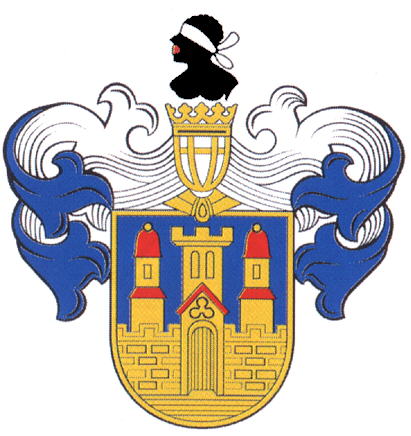Eisenberg (Thüringen)
EISENBERG
State : Thüringen
District (Kreis) : Saale-Holzland Kreis
Additions : 1994 Friedrichstanneck, Kursdorf, Saasa
| German |
In Blau eine gezinnte goldene Stadtmauer mit gezinntem Torturm und geschlossenem Tor. Hinter der Mauer links und rechts vom Hauptturm zwei ungezinnte Seitentürme mit roten Glockendächern, die Turmmitten der beiden Seitentürme sowie das Spitzdach des Tores in Rot. Der Schildfuß wird durch vier Querlinien begrenzt. Zwischen Mohrenrumpf und Wappenschild ein goldener Spangenhelm mit hellem Zier. Der Mohrenkopf trägt eine weiße Binde über den Augen und blickt nach rechts. Der Wappenschild wird zur Hälfte von einer blau-weißen Schabracke umrahmt. |
| English | blazon wanted |
Origin/meaning
The arms show a city view, a typical medieval design. The city already appeared on the oldest seals of Eisenberg, dating from the 14th century. During the 17th century the seals showed larger arms, still with the city view, but now with a helmet and as crest a moor's head.
There is a local story about the crest. Once upon a time one of the Counts of Eisenberg returned from a crusade to the Holy Lands with a black person (Moor) as a servant. Although he served well, he was still accused of stealing a golden necklace of the Countess. He subsequently was convicted to be beheaded even though he claimed to be innocent. The Countess, however, did not feel very good about the whole situation and while the hangman was preparing the scene, she took out her prayer book to pray for the poor servant. At that moment her golden necklace fell out of her prayer book, proving the innocence of the servant. She cried out to stop the execution and the servant was released. The count felt very ashamed and as a reminder to his shame he placed the blindfolded head as a crest above his arms. Later, the city adopted the crest from the arms of the counts.
| Seal from around 1900 |
The arms by Hupp in the Kaffee Hag albums +/- 1925 |
| The arms on a 1974 cover (with Arad) | |
| Postal cancellation 1975 |
Postal cancellation 1984 (with Gera and Stadtroda) |
Literature: Hupp, 1920s; Benzing et al, 1984; Ulle, 1998
